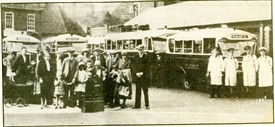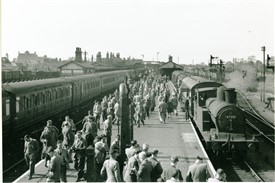When the Wheels of Industry Stopped Turning

Packed up and ready to go. Newark holiday-makers await their whit coated chauffeurs at the town's bus ststion on Lombard Street

Whether by road or rail, thousands of Newarkers made their way to the coast each Factory Fortnight. This picture shows Newark's Northgate station in 1953
'Factory Fortnight' Holidays
By Tim Warner
On a damp Saturday morning in July 1954 a mass exodus from Newark occurred when no fewer than 5,000 inhabitants left the town within the space of four hours.
More remarkable still, this curious phenomenon, which denuded the town almost instantaneously, of a tenth of its population, was for many years a regular feature in Newark’s social calendar.
For it was on these occasions – for two weeks every year – that the town’s main employers closed down their factories, enabling their workers to take a well-earned Summer break.
Workers
Only a skeleton staff (engaged on such necessary tasks as machine maintenance) would be retained at factories like Ransome & Marles’ (now RHP) and Worthington-Simpson’s (now Ingersoil - Dresser), as the main body of their workforce embarked on their annual holiday fortnight.
In 1954 no fewer than 3,500 workers were released from Ransome & Marles’, and over 700 from Worthington-Simpson’s.
Production at the two factories was halted completely, and, with the loss of so many people from the town – not just the workers themselves, but their spouses and families too – many shops, pre-empting the inevitable downturn in trade, joined in as well.
They too put up the shutters for a fortnight and allowed their own staff a Summer break. The normally bustling streets of Newark were rendered all but deserted.
Today, the annual Summer shut down still occurs in Newark, although the numbers involved are reduced, and the impact on trade in the town is much less marked.
Many of the smaller manufacturing firms which once participated in the scheme are no longer with us, although Ransome & Marles’ and Worthington-Simpson’s (albeit both under new ownerships) are still major employers in the town and still find the traditional holiday shutdown a most effective method of meeting both employee needs and company maintenance schedules.
Back in 1954 the “ Newark Advertiser” reported that the vast majority of Newarkers were heading – either by bus or train – to the Lincolnshire coast; Skegness or Cleethorpes.
“Crowds filled both platforms of Newark Northgate Station early on Saturday. Trains carried 250 Newarkers to London, 230 to the SouthCoast, 290 to the East Coast, and 150 to the west and south-west.”
Today, whilst those resorts remain popular, destinations are just as likely to include all points abroad, featuring countries and places hardly dreamed of as accessible or affordable in the fifties.
Trains
Describing the commencement of holiday fortnight in 1954 the “Advertiser” wrote: “The rush started soon after tea-time on Friday, and reached its peak in the damp and dull four hours from 6am on Saturday, when coast-bound coaches poured out of the town.
“Hundreds queued in the rain for motor-coaches…480 [were carried] to Skegness, 100 to Mablethorpe, 50 to Cleethorpes, and 400 to more distant resorts such as Yarmouth, Scarborough, Bridlington and Blackpool.
“Crowds filled both platforms of Newark Northgate Station early on Saturday. Trains carried 250 Newarkers to London, 230 to the SouthCoast, 290 to the East Coast, and 150 to the west and south-west.”
The reporter even went so far as to follow the crowds to Skegness and report on their progress. But even the delights of a fortnight on the East coast were extravagant by the standards of the first ever scheduled workmen’s holiday in Newark.
For the origins of the present two week break lie as far back as the 1880s when a Workmen’s Trip Committee, pioneered for the most part by employees at Nicholson’s iron foundry, was set up to encourage local companies to realise the benefits to both morale and productivity of an annual, organised outing.
In those early years, the Committee demanded merely one day for their outing, and, on the first occasion, organised a modest excursion to London.
The Great Northern Railway Company agreed, as an act of favour, to run a train to London for a fare of 4s. (20p) return so long as the Committee could guarantee 400 passengers.
Spectacle
Fortunately, almost double that number signed up for the trip, and many Newarkers visited the metropolis who had never been there before.
From those simple beginnings, over 100 years ago, arose the institutions that is today’s fortnight’s holiday, and which, in years not so long past, could lead to the remarkable spectacle of upwards of 5,000 people quitting the town in a matter of hours.